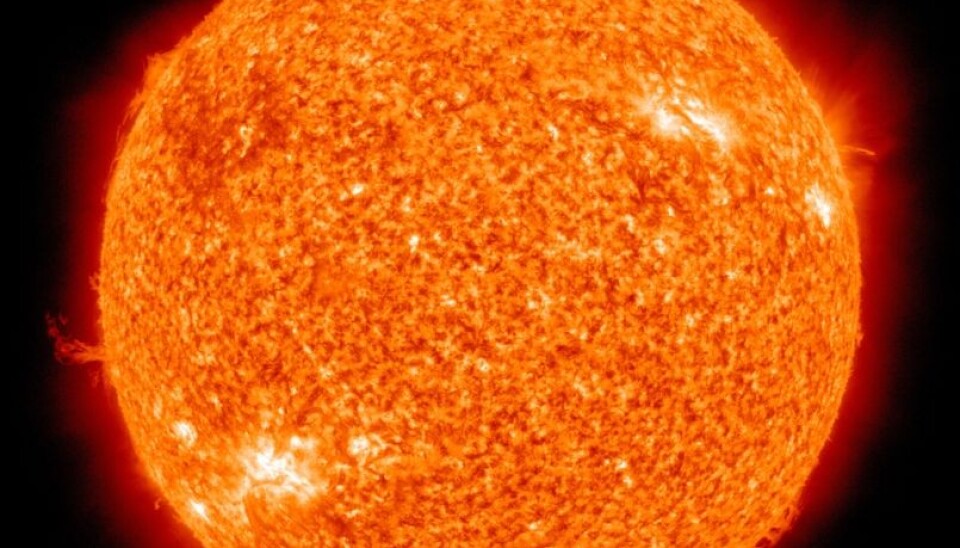An article from University of Tromsø – The Arctic University of Norway

Should we blame the Sun?
Is climate change man-made or is global warming due to solar insolation? Norwegian researchers have looked into a hypothesis that claims the Sun is to blame.
Denne artikkelen er over ti år gammel og kan inneholde utdatert informasjon.
Climate change can be confusing, especially because a number of researchers have criticised the UN Panel on Climate Change (IPCC).
"The effect of solar activity on climate change is one of the issues on which there remains some uncertainty in the IPCC's work," says Kristoffer Rypdal, a physics professor at the University of Tromsø. He is currently debating the issue with physicists Nicola Scafetta and Bruce West.
Is the Sun's effect underestimated?
In 2008, physicists Nicola Scafetta and Bruce West published an article entitled "Is climate sensitive to solar variability?"
The article argues in support of their hypothesis that there is a subtle complex link between the Sun's activity and variations in the Earth's climate. In essence, this hypothesis means that solar activity plays a crucial role in climate change on Earth.
The two researchers used a statistical review of variations in soil temperature and solar radiation to support their view.
The Sun can account for as much as 69 percent of the increase in the Earth's average temperature.
Some forecasts predict that the Sun will cool over the next few decades. Scaffetta and West believe this is good news because this cooling will stabilize the Earth's climate and we will avoid the disastrous consequences predicted in the IPCC's report.
They believe that the IPCC has grossly underestimated the Sun's influence on global warming.
"Scafetta and West are very active advocates for the Sun as the crucial factor in determing climate, and they are very skeptical about global warming," says Rypdal. “The methods they use are also quite unfamiliar to climatologists who argue that it is greenhouse gases that cause global warming."
Rypdal means that climatologists often don't have the right scientific tools to contradict Scaffetta and West, and have largely ignored their research.
In any case, this research focuses on complexity linking. Rypdal and his colleagues have much of the same academic background as Scafetta and West, and they wondered about their interpretation of the statistical data.
Complex relationships
With his son, mathematician Martin Rypdal, Rypdal decided to investigate the statistical arguments that Scafetta and West use to support their hypothesis.
In their article "Testing Hypotheses about the Sun-Climate Complexity Linking " in the highly rated scientific journal Physical Review Letters, the Rypdals show that the observations that Scafetta and West used as the basis for their hypothesis can be explained in another and far more plausible way.
"In short, Scafetta and West argue that although the correlation between solar activity and the Earth's global temperature is very weak, there is a common statistical signature in the two time series that cannot be arbitrary.”
Scaffeta and West believe that this means that there is a complex relationship between solar insolation and the Earth's climate.
“But what we have discovered is that these common traits are in fact random and that the relationship disappears when you correct for the trends in the time series," the Rypdals point out.
Conceptual Confusion
"The fundamental weakness of Scafetta and West's method is that they do not conduct a critical test of their own hypothesis," says Rypdal.
It is not sufficient to prove that a hypothesis provides predictions that match observations. A good hypothesis must provide many accurate predictions.
Rypdal believes some of the problems result from the difficulty in defining the term statistical trend. He says it is important to stick to the precise definition of what a trend is.
According to the physics professor there is a need to establish new mathematical concepts in the climate debate.
“Ambiguity in the terminology results in confusion in the discussion amongst researchers. If we are going to overcome this, we will have to have many interdisciplinary meetings," he says.
Conceptual confusion in the scientific community also leads to greater confusion in the public debate, and helps to blur the distinction between science and politics.
"We must be able to discuss each others' scientific arguments, because as soon as political motives come to the fore, conspiracy theories prevail. And then we confuse the public even more," he adds.
Scientific links
- M. Rypdal and K. Rypdal, "Testing Hypotheses about Sun-Climate Complexity Linking." Phys. Rev. Lett. 104, 128501 (2010) [4 pages].
- "Is climate sensitive to solar variability?", article by Nicola Scafetta and Bruce J. West






























